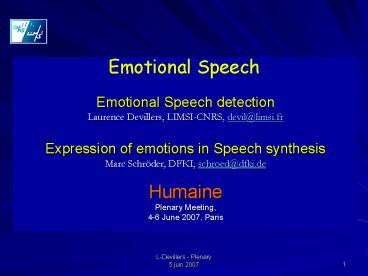Emotional Speech detection - PowerPoint PPT Presentation
1 / 17
Title:
Emotional Speech detection
Description:
Real-time system for 'real-life' emotional speech detection in order ... Annoyance, Impatience, ColdAnger, HotAnger. Anger. Fear, Anxiety, Stress, Panic, Embarrassment ... – PowerPoint PPT presentation
Number of Views:338
Avg rating:3.0/5.0
Title: Emotional Speech detection
1
Emotional Speech
- Emotional Speech detection
- Laurence Devillers, LIMSI-CNRS, devil_at_limsi.fr
- Expression of emotions in Speech synthesis
- Marc Schröder, DFKI, schroed_at_dfki.de
- Humaine
- Plenary Meeting,
- 4-6 June 2007, Paris
2
Overview
- Challenge
- Real-time system for real-life emotional speech
detection in order to build an affectively
competent agent - Emotion is considered in the broad sense
- Real-life emotions are often shaded, blended,
masked emotions due to social aspects
3
State-of-the-art
- Static emotion detection system (emotional unit
level word, chunk, sentence) - Statistical approach (such as SVM) using large
amount of data to train models - 4-6 emotions detected, rarely more
E models
0 0bservation
Emotion detection
P(Ei /O)
Extraction features
The scheme shows the components of an automatic
emotion recognition system The performances on
realistic data (CEICES) 2 emotions gt 80 4
emotions gt60
4
Automatic emotion detection
- The difficulty of the detection task increases
with the variability of the emotional speech
expression. - 4 dimensions
- Speaker (dependent/independent, age, gender,
health), - Environment (transmission channel, noise
environment), - Number and type of emotions (primary, secondary)
- Acted/real-life data and applications context
5
Emotion representation
Emotion in interaction .
gt5 Real emotions .
- gt4 acted
- -emotions
- 2- 5 realistic emotions
- (children, CEICES), HMI
- Real-life call-center emotions
HMI .
Call center data .
WoZ .
Acted/Woz/ real-life data
Quiet room
Speakers
Channel-dependent
- Speaker-independent
- Adaptation to gender
with adaptation
Personality, Health, Age, Culture
Environment Transmission
6
Challenge with spontaneous emotions
- Authenticity is present but there is no control
on the emotion - Need to find appropriate labels and measures for
annotation validation - Blended emotions (Scherer Geneva Airport Lost
Luggage Study ) - Annotation and Validation of annotation
- Expert annotation phase by several coders (10
coders, CEICES (5 coders), often only two) - Control of the quality of annotations
- Intra/Inter annotations agreement
- Perception tests
- Validate the annotation scheme and the
annotations - Perception of emotion mixtures (40 subjects)
NEG/POS valence - Importance of the context
- Give measure for comparing human perception with
automatic detection.
7
Human-Human Real-life Corpora
Audio Audio Visuel
8
- Context-dependent emotion labels
- Do the labels represent the emotion of a
considered task or context? - Example Real-life emotion studies (call center)
- The Fear label represents different expressions
of Fear due to different contexts - Fear for callers of losing money, Fear for
callers for life, Fear for agents of mistaking - The difference is not just a question of
intensity/activation - -gt Primary/Secondary fear ?
- -gt Degree of Urgency/reality of the threat ?
- Fear in the fiction (movies) study of many
different contexts - How to generalize ? Should we define labels in
function of the type of context? - We just defined the social role (agent/caller) as
a context
See Poster of C. Clavel
9
Emotional labels
- The majority of the detection systems uses
emotion discrete representation - Need a sufficient amount of data. In that
objective, we use hierarchical organization of
labels (LIMSI example)
10
No bad coders but different perceptionsCombining
annotations of different coders a Soft vector
of emotions
- Labeler 1 (Major) Annoyance, (Minor) Interest
- Labeler 2 (Major) Stress, (Minor) Annoyance
- ? (wM/W Annoyance, wm/W Stress, wm/W Interest)
- For wM2 , wm1 ,W6
- ? (0.5 Annoyance, 0.33 Stress, 0.17
Interest).
11
Speech data processing
LIMSI see Poster L. Vidrascu
- Standard features
- Pich level, range,
- Energy level, range
- Speaking rate
- Spectral features (formants, Mfccs)
- Less standard
- Voice quality local disturbances
(jitter/shimmer) - Disfluences (pauses, filler pauses)
- Affect bursts
- We need to automatically detect affect bursts and
to add new features such as voice quality
features - Phone signal is not of sufficient quality for
many existing techniques
WEKA toolkit (www.cs.waikato.ac.nz - Witten
Franck, 1999)
see Ni Chasaide poster
12
LIMSI Results with paralinguistic cues (SVMs)
from 2 to 5 emotion classes ( of good detection)
Fefear, Sdsadness Aganger Ax anxi,
Ststress, Re relief
13
25 best features for 5 emotions detection
Anger, Fear, Sadness, Relief Neutral state
Features from all the classes were selected
(different from one class to another)
The difference of the media channel
(phone/microphone), the type of data (adult vs.
children, realistic vs. naturalistic) and the
emotion classes have an impact on the best
relevant set of features. Out of our 5 classes,
Sadness is the least recognized without mixing
the cues.
14
- Real-life emotional system
- System based on acted data -gt inadequate for
real-life data detection (Batliner) - GEMEP/CEMO comparison different emotions
- First experiments show only an acceptable
detection score for Anger. - Real-life emotion studies are necessary
- Detection results on call center data state of
the art for realistic emotions - gt 80 2 emotions, gt 60 4 emotions, 55 5
emotions
15
Challenges ahead
- Short-term
- Acceptable solutions for targeted applications
are in reach - Use dynamic model of emotion for real-time
emotion detection (history memory) - New features Automatically extracted information
on voice quality, affect bursts and disfluences
from the signal that does not require exact
speech recognition. - Detect relaxed/tensed voice (Scherer)
- Add contextual knowledge to the blind statistical
model social role, type of action, regulation
(adapt emotional expression to strategic
interaction goals (faces theory, Goffman)). - Long-term
- Emotion dynamic processus based on appraisal
model. - Combining informations at several levels
acoustic/linguistic, multimodal cues, adding
contextual informations (social role)
16
Demo (coffee break)
17
Thanks































